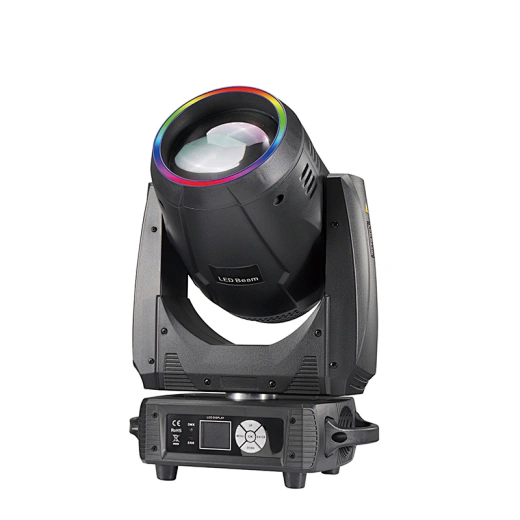Introduction
Choosing the correct beam angle for LED lighting is a critical yet often misunderstood aspect of stage and event lighting design. Many professionals and beginners alike make common mistakes that can compromise the visual quality, audience comfort, and overall impact of a performance. In this article, we will explore these misconceptions, provide guidelines for choosing the right beam angles for different scenarios, and recommend professional solutions from Blue Sea Lighting, including the Module 100W Beam LED Moving Head with Halo.
1. Understanding Beam Angle
The beam angle refers to the angle at which the light’s intensity falls to 50% of its maximum value. It determines how wide or narrow the light spreads, directly affecting the size of the illuminated area, intensity, and visual effect.
Narrow Beam (5°–15°): Concentrated light, high intensity, suitable for long-throw highlighting.
Medium Beam (20°–40°): Balanced coverage and brightness, suitable for general stage lighting.
Wide Beam (45°+): Large coverage, lower intensity, ideal for washes and ambient lighting.
2. Misconception One: Smaller Beam Angles Are Always Brighter
Many assume that a smaller beam angle will automatically improve lighting quality.
Reality: While narrow beams concentrate light, they can cause hotspots and leave surrounding areas underlit.
Correct Approach:
Use narrow beams only for focused effects, like spotlighting a solo performer.
For wide coverage, opt for medium or wide beams to ensure even illumination.
3. Misconception Two: Beam Angle Choice is Independent of Stage Size
Ignoring the stage’s dimensions is a common mistake.
Reality: Beam angles that are too narrow on a large stage cause dark edges; too wide and brightness drops significantly.
Correct Approach:
Match beam angle to stage size and fixture height.
For a stage 10m wide with fixtures at 6m height, a 40° beam offers balanced coverage.
4. Misconception Three: Fixture Position Does Not Affect Beam Angle Selection
Some lighting designers overlook installation height and distance.
Reality: The same beam angle behaves differently when the fixture height changes. Lower positions reduce coverage and create sharper light falloff.
Correct Approach:
Increase beam angle for low-hung fixtures to broaden coverage.
Use narrower beams for high-mounted fixtures to maintain brightness.
5. Misconception Four: All Performances Need the Same Beam Angle
Different performance types have varying lighting needs.
Reality: A play’s dialogue scenes require precise, narrow beams, while dance performances often benefit from wide washes.
Correct Approach:
Drama: 15°–25° for controlled key lighting.
Concerts: 20°–40° for energy and movement.
Dance: 40°–60° for soft, even coverage.
6. Misconception Five: Relying Solely on Manufacturer Specifications
Beam angle numbers can vary between brands and optical systems.
Reality: A listed 20° beam from one brand may perform differently from another due to lens design, LED type, and reflector quality.
Correct Approach:
Review photometric data and light distribution charts.
Test fixtures in real scenarios before finalizing purchases.
7. How to Calculate the Right Beam Angle
Formula: Beam Diameter ≈ 2 × Height × tan(Beam Angle ÷ 2)
Example: For a height of 6m and a beam angle of 30°,
Beam Diameter ≈ 2 × 6 × tan(15°) ≈ 3.2m
This helps ensure adequate coverage without over- or under-lighting areas.
8. Product Recommendation: Blue Sea Lighting Solution
Module 100W Beam LED Moving Head with Halo
This fixture offers exceptional versatility with a concentrated beam for precision effects and a halo ring for added visual impact. It is ideal for both small and large venues, providing flexibility in beam angle usage and dynamic stage visuals. Its lightweight design, energy efficiency, and smooth pan/tilt control make it a valuable addition to any lighting rig.

9. Practical Tips for Beam Angle Optimization
Combine different beam angles to create depth and dimension.
Use narrow beams for highlighting and wide beams for general wash.
Employ gobo effects with narrow beams for texture on backdrops.
For immersive experiences, synchronize beam changes with music or scene transitions.
10. Maintenance and Energy Efficiency
LED fixtures consume less power and have longer lifespans than traditional lamps. Choosing the right beam angle not only improves the audience experience but also reduces the number of fixtures needed, cutting costs in both purchase and operation.
Conclusion
Avoiding common misconceptions in beam angle selection is essential for achieving professional lighting results. By understanding beam physics, considering stage dimensions, and selecting reliable products like the Module 100W Beam LED Moving Head with Halo from Blue Sea Lighting, lighting designers can enhance both the technical quality and artistic impact of their productions.





Blue Sea Lighting is an enterprise with rich experience in the integration of industry and trade in stage lighting and stage special effects related equipment. Its products include moving head lights, par lights, wall washer lights, logo gobo projector lights, power distributor, stage effects such as electronic fireworks machines, snow machines, smoke bubble machines, and related accessories such as light clamps.
Quick Links
For more questions subscribe to our email








